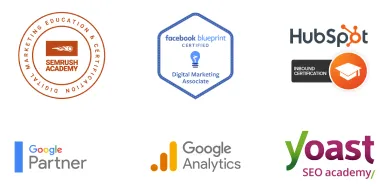TO LEARN IS TO GROW
Learning Center
We do our research and publish our results. Should probably call this the Growing Center.


Buyer Personas: Why They are Essential and Why You Should Have Them
For every business, growth is key. That means constantly building new relationships, reaching out to more leads, all for the purpose of driving sales.
Even as marketers, we understand that our products are not for everyone. Not everybody has a need for our product or a desire for it, and that’s just how it is. Our job is to focus on what little resources, energy, and time we have towards connecting with people who do find our products and services relevant or useful. And this is where buyer personas come in.
What is a Buyer Persona?
A buyer persona is a semi-fictional representation of your ideal buyer based on data, interviews, and some educated guesses (Hubspot).
It’s a representation of your brand’s ideal buyer– sort of like a character that you might use in a role-playing game or when you’re writing a novel. Your buyer persona has all these little details fleshed out so that it sounds like you have a specific person in mind.
Ultimately, these buyer personas help you understand your customers (or types of customers) much better since you have a more realistic idea of their motivations, their pain points, and what might make them choose you and your products and services over your competitors’.
Buyer personas make it easier for you to create content, special promotional offers, or other marketing campaigns according to the very specific needs, behaviors, and concerns of your different target market segments.
How Do I Create My Own Buyer Personas?
The more data you can get on your customers, the better. That said, you create your buyer personas based on the insights that you might get from:
First-hand interaction of your target audience
Market research
Insights and analytics that you might get from social media, or through your website
Surveys, interviews, and focused group discussions.
You can draw from a pool of customers, prospective clients, or those within a particular demographic or interest group, or anyone else outside of your database that might just align with your target audience.
Some of the more practical methods for gathering the information you need to develop your buyer personas include:
Interviewing customers either in person, over the phone, or as a small group to discover what it is exactly they like about your product or service.
Looking through your database of leads and contacts to uncover trends about how certain customers find and consume your content.
Talking to your business’ front liners– those who regularly engage with customers, especially those who keep coming back.
Peeking into your Facebook Insights or Google Analytics to get some interesting trends, and observing how these change over time.
Make sure you’re consistent and thorough when you’re collecting information. If you’re using forms on your website, make sure you have the correct fields to capture the data you need.
Don’t forget to involve your sales team, as they have the best idea of what sales objections they need to hurdle before closing a sale, or what the usual concerns are before a client has been convinced to make that purchase.
The best buyer personas are developed from a good mix of the insights you get from your market research together with the interactions from your actual customer base.
Depending on what sort of products and services you offer, you might have multiple buyer personas as you’re moving actively within different niches and market segments. However, we recommend you start identifying your main bread-and-butter audience(s) and develop those buyer personas first. Then you can move down the line with your other secondary target audiences, and create buyer personas for each of those.
The Concept of Negative Personas
Just in the same way you have a representation of your ideal customer, it might also help to have a similar representation of someone you don’t want as a customer– a negative persona.
There’s a variety of reasons why you wouldn’t want a specific set of customers, and determining a negative persona helps you, your marketing team, your sales team, and services team focus their energy and resources on more important market segments.
Common negative personas might include:
Clients who are not at a stage in their life when they need you
Clients whose knowledge or skill sets are too advanced for your product or service
Customers who might have a tendency to churn or not ever come back to purchase again from you
Students who engage with your content mostly just for research
Customers who are just too expensive to acquire compared to the amount of business they bring in.

A Final Word About Buyer Personas
Buyer personas, at the very least, allow you to more effectively target your marketing efforts for different segments of your target audience.
This means that, instead of just sending out one generic newsletter in your database of clients, you can actually segment your leads according to buyer persona and create more customized content to better engage and move them further down the buyer’s journey.
Negative personas also help you avoid certain customers so that you can easily identify these and not have to waste much time or effort that would have otherwise gone towards more productive lead nurturing efforts, thereby helping boost sale productivity.
Finally, it’s always a good practice for everyone in your team— including sales, marketing, services, management– to know about your company’s buyer personas as well. Having a unified front not only helps your team better understand the business, but it also helps in your overall branding efforts as your communications are consistent, steady, and on-point across the board.
For even more information and help on the topic of buyer personas, consider checking out our good friends over at HubSpot. They even have this downloadable guide with templates to help you come up with buyer personas for your own brand.
Built for Growth. Backed by 25 Years of Trust.
For over two decades, LOJO has been a trusted partner to hundreds of businesses just like yours. Whether working directly with owners, managers, teams, or boards of directors, our goal remains the same: to be a reliable and results-driven asset to your business.
Over the years, we’ve carefully built a team of experts—each selected for their unique skills, strengths, and personalities. Our clients choose LOJO because they know we genuinely care about their success.
And after 25 years of helping businesses grow, we’re more committed than ever.



Built for Growth. Backed by 25 Years of Trust.
For over two decades, LOJO has been a trusted partner to hundreds of businesses just like yours. Whether working directly with owners, managers, teams, or boards of directors, our goal remains the same: to be a reliable and results-driven asset to your business.
Over the years, we’ve carefully built a team of experts—each selected for their unique skills, strengths, and personalities. Our clients choose LOJO because they know we genuinely care about their success.
And after 25 years of helping businesses grow, we’re more committed than ever.




Matthew Rogers, President
iProspect Check
After spending several months reviewing multiple proposals from several different companies we engaged LOJO to develop a new website that represents our company effectively. We worked initially with Stephen Platte who helped create the scope of the project. Stephen was knowledgeable and always followed up with me on time and as promised.
He "closed the deal" for LOJO with his professionalism, service orientation and easy going approach. Once we signed the contract we were introduced to Jay Kelly who would be the creative lead for LOJO. This was the most challenging part of the project for my company, as there was no shortage of ideas from our side. Jay managed the project flawlessly, and once we had all agreed to the design, Jay introduced us to Eric.
Eric Lay is one of the founders of LOJO. Eric took the design we had developed and brought it to life. We delivered content as quickly as he requested it. Eric kept the project on task and we responded by exceeding every deadline for content. In turn, once provided, literally not a day went by that Eric didn't add the content and take the next step. In just a few weeks we launched our new website. Eric is a pleasure to work with.
His positive attitude and consultative approach really enhanced the experience and made a big difference for us in the outcome of our project. We would welcome you to visit our website to take a look at the quality work of LOJO. We are very pleased with LOJO and look forward to working with them in the future as we pursue an aggressive SEO strategy."
After spending several months reviewing multiple proposals from several different companies we engaged LOJO to develop a new website that represents our company effectively. We worked initially with Stephen Platte who helped create the scope of the project. Stephen was knowledgeable and always followed up with me on time and as promised.
He "closed the deal" for LOJO with his professionalism, service orientation and easy going approach. Once we signed the contract we were introduced to Jay Kelly who would be the creative lead for LOJO. This was the most challenging part of the project for my company, as there was no shortage of ideas from our side. Jay managed the project flawlessly, and once we had all agreed to the design, Jay introduced us to Eric.
Eric Lay is one of the founders of LOJO. Eric took the design we had developed and brought it to life. We delivered content as quickly as he requested it. Eric kept the project on task and we responded by exceeding every deadline for content. In turn, once provided, literally not a day went by that Eric didn't add the content and take the next step. In just a few weeks we launched our new website. Eric is a pleasure to work with.
His positive attitude and consultative approach really enhanced the experience and made a big difference for us in the outcome of our project. We would welcome you to visit our website to take a look at the quality work of LOJO. We are very pleased with LOJO and look forward to working with them in the future as we pursue an aggressive SEO strategy."

Matthew Rogers, President
iProspect Check
The team at LOJO were wonderful to work with. They are well organized and very patient as we worked through our marketing strategy and developed a well thought out and clear action plan at a reasonable price. We will definitely be back for our future campaign needs."

Jon Crosby, Founder
Dazil

